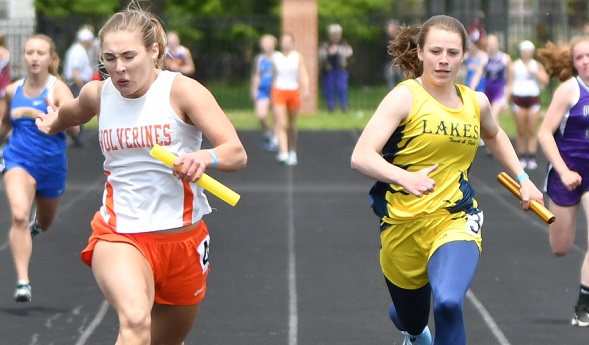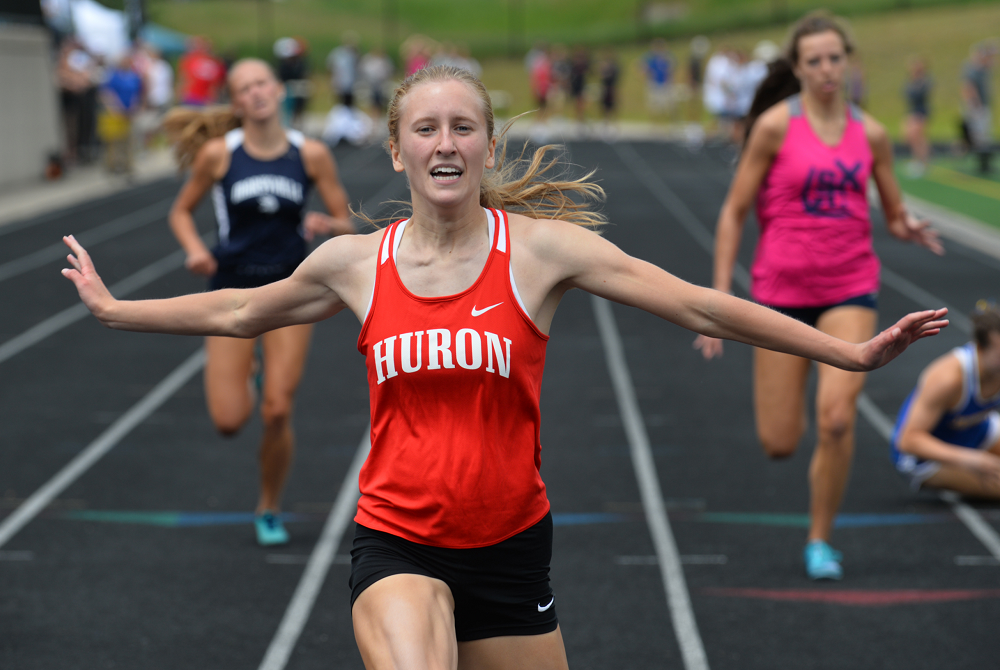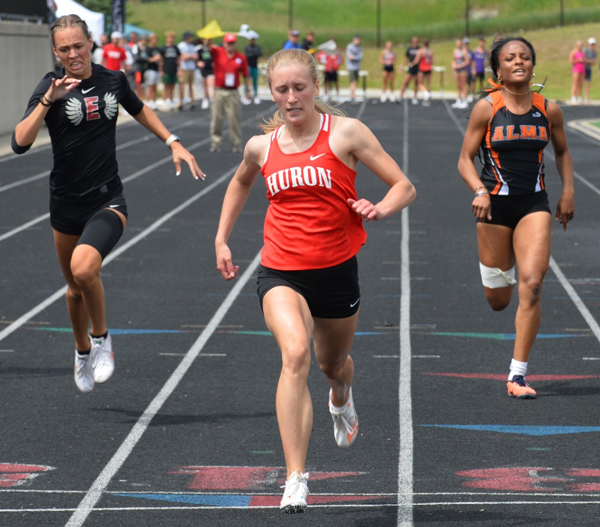
Many Do Their Parts to Drive Lakes 3-Peat
June 1, 2019
By Adam Niemi
Special for Second Half
KINGSFORD – Lake Linden-Hubbell cruised to its third straight MHSAA Division 3 UP Finals championship Saturday.
The Lakes scored 112 points, well ahead of runner-up Felch North Dickinson's 62.
"It's just unbelievable. We knew where we were on paper; we had the most points from our seeding. We know that that never works out," Lake Linden-Hubbell head coach Gary Guisfredi said. "We talked to the girls about how important it was to work for our personal bests, which we got a lot of those today. We also talked about how important it is to, if we're seeded fifth, to get to fourth and bump up. We had that today. We had multiple girls who were not seeded one through six, came out of other heats and actually placed. It really was just an amazing day."
Rock Mid-Peninsula was third (56), followed by Brimley (45) and Stephenson (42) to round out the top five.
The Lakes' third straight title came on the strength of gritty determination and hard work, embodied by Sienna Anderson's comeback from an ACL injury a year ago. She took second in the 100 hurdles behind Brimley's Hayley Gamberdella.
The Lakes took five firsts including wins in the 400 meter and 1,600-meter relays. Mariah Willmer won the 800 run. Jamie Hendrickson won the high jump, and Camaryn Crouch won the pole vault.
Lake Linden-Hubbell's biggest calling card was getting multiple girls piling points in the same event. Three Lakes took the top three places and 24 points in the pole vault, led by Crouch. It was around then that the Lakes padded the lead.
"All of a sudden we went from close, to not so close anymore," Guisfredi said. "I'm just really, really blessed with this group. I'm so happy for them because they've just worked so hard. All the kids work hard, but this has been a fun group."
 Masyn Alexa's big day helped North Dickinson's small team to a runner-up finish.
Masyn Alexa's big day helped North Dickinson's small team to a runner-up finish.
The Nordics sent just six girls to the UP Finals. Lake Linden-Hubbell had 16.
"We really competed well today. Hats off to Lake Linden. They had a great day," North Dickinson head coach Mike Roell said. "We got beat by a really good track team today, but we beat a lot of good track teams to come in second here today. We're really proud of our kids. All year we've been working hard, and it paid off today. I can't say enough. Masyn Alexa broke two school records in the 200 and 400 dashes. She kind of carried us through this thing. We had a lot of young girls that worked their tails off and scraped up enough points to get runner-up. We're really proud of that."
Alexa, a junior, won and set a school record in the 400 with a time of 1:00.86. She held the previous record from last year.
"I've been working to get that record for a long time,” she said. “I ran high 1:01 three different times last year and once again this year. In practice two days ago I was three hundredths of a second away from getting it. I was hoping today I could get it, and I ended up getting it. My coach was at the 200 mark, marking my time as I came across. Then I knew what I was at so I could finish strong.
"I wasn't sure if I had it or not. I knew I was close. I heard all the cheers as I went across. I didn't know whether I had it or not. When I looked, my mom was nodding so I knew I had it."
Alexa also set a new record in the 200, improved by 13 hundredths of a second.
Alexa barely edged Stephenson's Amanda Starzynski to win the 200, by nine hundredths of a second. She was also the fourth leg of the 400 relay that took second behind Lake Linden-Hubbell.
The Nordics also took second in the 800 and 1,600 relays. Hannah Clark placed fourth in the pole vault. Briana Smith was third in the long jump. Skye Ledzian was third in shot put and fifth in discus.
Starzynski leaned forward while crossing the finish line to edge Alexa in the 100 dash by a hundredth of a second. She also anchored the Eagles' 400 relay team that took fifth, and won the long jump.
Baraga's Jaylyn Lindemann won the shot put at 31 feet, 3.5 inches.
PHOTOS: (Top) Rock Mid-Peninsula's Camryn Croadsell, left, and Lake Linden-Hubbell's Joslyn Perala charge toward the finish in the 400 relay. (Middle) North Dickinson's Sophie Mattson runs the 3,200. (Photos by Cara Kamps.)

Multi-Sprint Champ Racing to Finish Huron Career Ahead of the Rest Again
By
Keith Dunlap
Special for MHSAA.com
May 25, 2023
NEW BOSTON – If there was one thing Elizabeth Anderson took pride in elementary school, it was simply showing that she could outrun everyone in sight.
 In fact, Anderson has an explanation for all the success she had in those playground races.
In fact, Anderson has an explanation for all the success she had in those playground races.
“Dominance when you are in elementary school,” Anderson quipped. “I don’t think I ever had a nickname. I just think everyone knew I was fast.”
Years later, pretty much everyone who follows track & field in the state of Michigan can attest to that.
A senior for New Boston Huron, Anderson has been faster than most other competitors in the state during her three-year high school career (with her freshman season in 2020 canceled due to COVID-19).
Last year, Anderson won titles at the Lower Peninsula Division 2 Finals in the 200-meter (25.07) and 400-meter (56.28) dashes, and was runner-up in the 100-meter dash (12.23).
Often, top sprinters focus on one or two of those three races. But Anderson is certainly a different breed of sprinter because she does all three.
In fact, she holds school records in all three of those events, and if all that weren’t enough, Anderson is a part of all three sprint relay teams.
“It is hard to give her events off,” said New Boston Huron head girls track coach Danielle Lobato.
Despite the different styles the 100, 200 and 400-meter dashes present, Anderson said there usually isn’t much adjusting when she goes from one of those races to another.
 The strategy is simply, “Let’s beat the other girls to the finish line.”
The strategy is simply, “Let’s beat the other girls to the finish line.”
“I don’t really go into each race changing up how I would run,” she said.
While enjoying and succeeding in all three races, Anderson said she actually does have a favorite among them.
“I would say the 400 is probably my favorite,” she said. “Even though it hurts, it’s satisfying to see how much you can get your time down in the 400 compared to any other race.”
Anderson said she started running track in sixth grade, but really got serious about it during the summer after her sophomore season, when she was invited to run for a local club.
Eventually, that led to her competing over the winter in indoor events.
She lived and breathed track so much that last fall, she decided to not run cross country so she could focus on a weightlifting regimen aimed at developing more leg strength.
“Once I started doing summer track, I realized I wanted to be doing this all the time,” she said.
Lobato said oftentimes in practice, Anderson is a de facto coach, given there is no better person she can think of for the younger runners on the team to learn from.
“I can’t always demonstrate these things I’m trying to teach,” she said. “You get to see it in real life (from Anderson), not in a YouTube video.”
After winning the 100, 200 and 400-meter dashes at her Regional meet last week, Anderson has her sights set on achieving the same trifecta of titles at next Saturday’s Finals in Grand Rapids.
Anderson has signed to run track at Michigan State, but has been plenty motivated to keep producing this spring in her final high school season.
“I’m really looking to defend my titles,” she said. “That is what is really motivating me to keep going. I want to keep in shape for the college season. I don’t want to lose any of the progress I have made. Ultimately, I just love running track.”
And since elementary school, Anderson has loved — and succeeded in — outrunning everyone else to the finish line.
“We knew we were getting something special,” Lobato said of when Anderson arrived in high school. “But you never expect this. All that she has accomplished is amazing.”
 Keith Dunlap has served in Detroit-area sports media for more than two decades, including as a sportswriter at the Oakland Press from 2001-16 primarily covering high school sports but also college and professional teams. His bylines also have appeared in USA Today, the Washington Post, the Detroit Free Press, the Houston Chronicle and the Boston Globe. He served as the administrator for the Oakland Activities Association’s website from 2017-2020. Contact him at [email protected] with story ideas for Oakland, Macomb and Wayne counties
Keith Dunlap has served in Detroit-area sports media for more than two decades, including as a sportswriter at the Oakland Press from 2001-16 primarily covering high school sports but also college and professional teams. His bylines also have appeared in USA Today, the Washington Post, the Detroit Free Press, the Houston Chronicle and the Boston Globe. He served as the administrator for the Oakland Activities Association’s website from 2017-2020. Contact him at [email protected] with story ideas for Oakland, Macomb and Wayne counties
PHOTOS (Top) New Boston Huron's Elizabeth Anderson clears the finish line during last season's LPD2 400 race. (Middle) Anderson, middle, outpaces the field to also win the 200. (Click for more from RunMichigan.com.)

